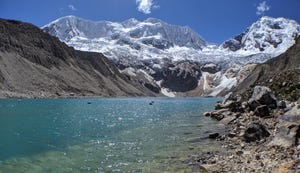
An Overlooked Threat From Climate Change Puts Millions at Risk Right Now - CNET
Rising sea levels and the potential impacts to huge coastal populations worldwide rank near the top of concerns when it comes to fallout from an escalating climate emergency. But a lesser-known danger poses an equal or arguably more imminent threat to millions around the world living at much higher altitudes: flooding from glacial lakes.
With average temperatures rising around the world in recent decades, a number of these lakes high above population centers in South America and Asia have become swollen and unstable as the reserves of snow and ice that feed them melt ever quicker.
For the first time, an international team of researchers has quantified this threat. It reports in a study published Tuesday in the journal Nature Communications that 15 million people are in the path of potential floods from these bloated bodies of water. More than half of that total live in just four countries: Peru, India, Pakistan and China.
“Understanding which areas face the greatest danger from glacial flooding will allow for more targeted and effective risk management actions, which in turn will help minimize loss of life and damage to infrastructure downstream,” co-author Rachel Carr, head of physical geography at Newcastle University, said in a statement.
In 2013, a glacial lake outburst flood, or GLOF, brought on by rainfall killed thousands in the Indian state of Uttarakhand. A number of other high-risk sites have been identified around the world.
A few years ago, I visited the Cordillera Blanca range of the Peruvian Andes, which is home to a number of dangerous glacial lakes. A 1941 GLOF from Lake Palcacocha there killed thousands in the town of Huaraz below and largely inspired the beginning of research into the phenomenon. Dams and other infrastructure were put in place to mitigate the threat from the lake in the 1970s, but its volume is now over 30 times greater, requiring new modifications to safely drain and release water pressure.
Other dangerous lakes nearby threaten smaller towns, where almost no mitigations are in place to reduce the threat.
Lead researcher Caroline Taylor from Newcastle says the researchers also found that understanding the danger requires more than just counting lakes and measuring their volume.
“Instead, it is the number of people, their proximity to a glacial lake and importantly, their ability to cope with a flood that determines the potential danger from a glacial lake outburst flood (GLOF) event.”
That coping ability faces challenges of infrastructure and resources present in the nations where the threat is the largest. A number of international efforts are now working to provide better monitoring of the danger.
In recent years, a warning system was installed at Lake Palcacocha that could give residents of Huaraz enough time to get out of the way of an incoming flood. Meanwhile, other threatened villages with no such alert system continue to rely on hope and luck.


